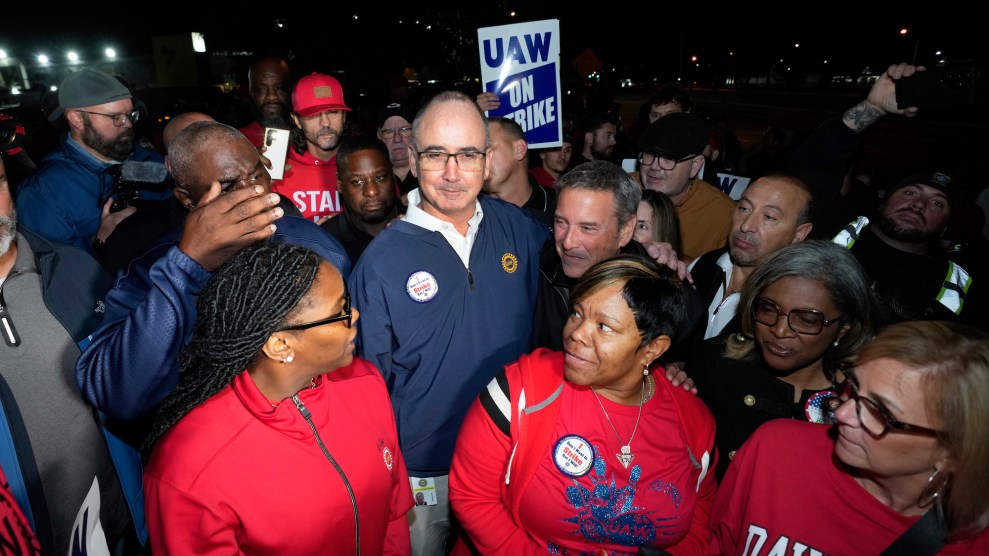
UAW President Shawn Fain stands with members striking at Ford's Michigan Assembly Plant in Wayne, Michigan, at the start of the strike.Paul Sancya/AP
For the first time in US history, UAW members at the Big Three automakers are on strike at the same time. The walkout began when the union’s contract expired early Friday morning.
UAW President Shawn Fain announced the initial strike targets during a Thursday night speech. The short notice is part of a new strategy under which the union is striking at targeted sites, rather than across a company. The goal is to maximize leverage by keeping automakers guessing about when and where workers will withhold their labor.
The initial targets are the General Motors assembly plant in Wentzville, Missouri, the Stellantis (formerly Chrysler) assembly complex in Toledo, Ohio, and part of a Ford assembly plant in Wayne, Michigan. Roughly 13,000 UAW members are striking at those facilities. All three make trucks and SUVs, which have been key to US automakers’ profitability.
The UAW has more than 145,000 members across the Big Three. Fain said on Thursday that the union is prepared for everyone to go on strike if needed—stressing that all options remain on the table.
The UAW and the Big Three remain far apart in their negotiations. The union is pushing for a more than 30 percent increase in pay over the course of the four-year contract. Members also have been fighting for guaranteed cost-of-living adjustments, an end to tiered-pay systems that put new hires at a disadvantage, a return to defined-benefit pension plans, a four-day work week without a reduction in pay, and a right to strike over plant closures. The auto companies have offered to increase pay by between 17.5 and 20 percent, but remained opposed to the UAW’s top demands, Fain said earlier this week.
The union is estimated to have $825 million in its strike fund. Workers will be paid $500 per week by their union while they are on strike. The UAW’s strike authorization vote passed last month with 97 percent support. In a recent Gallup poll, 75 percent of Americans said they sympathize more with autoworkers than their employers in the ongoing labor dispute.
In the past, the UAW has targeted one auto company, rather than all three at once. The goal was to get one company to agree to a contract, which would then be adopted by the other members of the Big Three. In 2019, more than 48,000 workers at GM struck for 40 days before reaching an agreement.
Full-time autoworkers start at $18 per hour under the expired contract. They can reach the top rate of $32 per hour after eight years. The UAW sees the current negotiations as a chance to make up for concessions such as the suspension of cost-of-living adjustments that autoworkers accepted to help automakers survive the 2008 crisis that resulted in GM and Chrysler declaring bankruptcy. The lack of a COLA has contributed to US autoworkers’ average hourly earnings falling by nearly 20 percent in real terms since 2008, according to the Economic Policy Institute.
The Big Three have made roughly $250 billion in profits over the past decade, while spending nearly $66 billion on dividend payments and stock buybacks. CEO pay increased 40 percent during that period. In the first half of this year, they recorded an additional $21 billion in profit. The UAW’s stance is that “record profits mean record contracts.”
Fain was elected by members earlier this year as part of an effort to take the union in a more militant direction and push aside the old guard following years of high-level corruption. In a break with tradition, Fain did not publicly shake hands with Big Three CEOs when negotiations began in July. He later threw a contract proposal from Stellantis into the trash during a Facebook livestream. On Friday afternoon, Sen. Bernie Sanders (I-Vt.) will join Fain and other UAW members at a rally in Detroit.
Shawn Fain, president of @UAW, just went live to read the contract proposals from Stellantis, which owns Chrysler and Fiat.
Fain is pushing for big gains in this contract, and says that Stellantis is only looking for concessions.
So he throws the document in the trash. pic.twitter.com/arE3guzeSH
— More Perfect Union (@MorePerfectUS) August 8, 2023
Fain has framed the strike as a way to fight against a system rigged against workers. During a Wednesday livestream, he turned to scripture to make that case. “Why is it easier for a camel to pass through the eye of a needle than for a rich person to enter the kingdom of God?” he asked, citing the Gospel of Matthew. “I have to believe that answer, at least in part, is because in the kingdom of God, no one hoards all the wealth, while everybody else suffers and starves.”
“In the kingdom of God, no one puts themselves in a position of total domination over the entire community,” Fain continued. “In the kingdom of God, no one forces others to perform endless backbreaking work just to feed their families, or put a roof over their heads. That world is not the kingdom of God. That world is hell.”
Editor’s note: The author of this post and other Mother Jones workers are represented by UAW Local 2103.
















